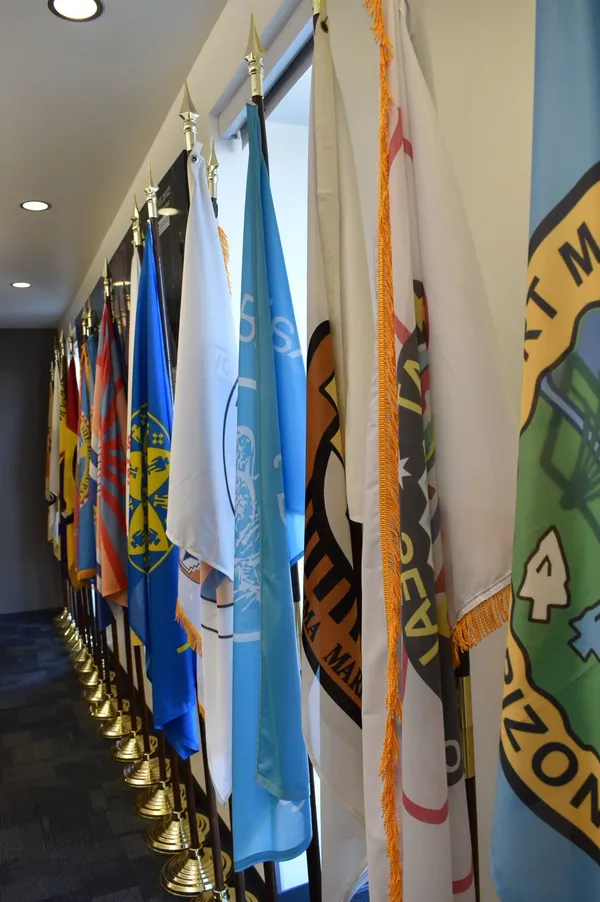
- Details
- By Neely Bardwell
On March 18, the flags of Arizona’s 22 tribal nations were removed from the Carl. T. Hayden VA Medical Center in central Phoenix and returned back to the Salt River-Pima Maricopa Indian Community. This has sparked outrage among the Tribes in Arizona.
This is part of a new flag policy implemented by the Department of Veteran Affairs that limits the display of flags at VA facilities. The policy is “intended to establish consistency across the department and aligns with longstanding Department of Defense guidelines,” the VA stated in a news release.
Only the U.S. flag, flags of U.S. states and territories, military service flags, VA flags and official flags of U.S. agencies, and flags representing prisoners of war/missing in action (POW/MIA), Senior Executive Service (SES), military command units and burial flags for honoring Veterans and reservists are permitted.
Salt River-Pima Maricopa Indian Community Vice-President Ricardo Leonard is calling on Veterans Affairs Secretary Doug Collins to restore the display of all tribal nation flags at the Phoenix VA hospital.
“I was surprised and appalled when the staff of the Phoenix Veterans Affairs hospital dropped off all 22 Arizona Tribal Nation flags at our office, explaining that they could no longer display them,” Leonard said in a statement.
Gila River Indian Community Gov. Stephen Roe Lewis sent an angry letter to the VA calling for the flags to be brought back to the hospital.
"(The removal) ignores the long-standing recognition that tribes and tribal membership is a political status, not a racial classification," Lewis said.
The move comes shortly after the U.S. Department of Defense began deleting websites about the Navajo Code Talkers who were instrumental to America’s victory in the Pacific Theater in World War II.
Indigenous people across the United States have the highest serving rate, serving in the armed forces at five times the national average, according to the National Indian Council on Aging, and have served with distinction in every major conflict for over 200 years.
More Stories Like This
Native News Weekly (August 25, 2024): D.C. BriefsUS Presidents in Their Own Words Concerning American Indians
Oral History Project Announces 14th Stop in Portland, Oregon: NABS Continues to Gather Crucial Stories Across Indian Country
Deb Haaland Releases Statement on 2025 Election Results
Instead of Native American Heritage Month Proclamation, Trump Issues A Message
Help us tell the stories that could save Native languages and food traditions
At a critical moment for Indian Country, Native News Online is embarking on our most ambitious reporting project yet: "Cultivating Culture," a three-year investigation into two forces shaping Native community survival—food sovereignty and language revitalization.
The devastating impact of COVID-19 accelerated the loss of Native elders and with them, irreplaceable cultural knowledge. Yet across tribal communities, innovative leaders are fighting back, reclaiming traditional food systems and breathing new life into Native languages. These aren't just cultural preservation efforts—they're powerful pathways to community health, healing, and resilience.
Our dedicated reporting team will spend three years documenting these stories through on-the-ground reporting in 18 tribal communities, producing over 200 in-depth stories, 18 podcast episodes, and multimedia content that amplifies Indigenous voices. We'll show policymakers, funders, and allies how cultural restoration directly impacts physical and mental wellness while celebrating successful models of sovereignty and self-determination.
This isn't corporate media parachuting into Indian Country for a quick story. This is sustained, relationship-based journalism by Native reporters who understand these communities. It's "Warrior Journalism"—fearless reporting that serves the 5.5 million readers who depend on us for news that mainstream media often ignores.
We need your help right now. While we've secured partial funding, we're still $450,000 short of our three-year budget. Our immediate goal is $25,000 this month to keep this critical work moving forward—funding reporter salaries, travel to remote communities, photography, and the deep reporting these stories deserve.
Every dollar directly supports Indigenous journalists telling Indigenous stories. Whether it's $5 or $50, your contribution ensures these vital narratives of resilience, innovation, and hope don't disappear into silence.
 The stakes couldn't be higher. Native languages are being lost at an alarming rate. Food insecurity plagues many tribal communities. But solutions are emerging, and these stories need to be told.
The stakes couldn't be higher. Native languages are being lost at an alarming rate. Food insecurity plagues many tribal communities. But solutions are emerging, and these stories need to be told.
Support independent Native journalism. Fund the stories that matter.
Levi Rickert (Potawatomi), Editor & Publisher

